Introduction – What Happens When You Flip the Switch?
The moment you press a switch and the light turns on—something invisible travels instantly through wires. That invisible something is electricity, and it flows through special routes called circuits.
Electricity isn’t just powering your lamp or laptop—it’s powering how the world works.
expert-led Physics classes – visit our website to learn more
WHO Works With It?
Electricity isn’t just for “scientists.” It’s for everyone who builds, fixes, or uses tech in daily life:
- Electricians – wire buildings and homes
- Tech Creators – design phones, robots, and gadgets
- Inventors – make new machines using circuits
- You – every time you charge, click, or connect!
WHY Is Electricity Important?
Without electricity, life would pause. It:
- Lights up our homes and streets
- Powers machines, hospitals, schools
- Runs our phones, laptops, TVs, and internet
- Helps us cook, clean, travel, and stay cool or warm
- Enables scientific tools, space missions, and more
WHEN Did It All Begin?
Electricity wasn’t invented—it was discovered.
- Ancient times: People noticed sparks from rubbing fur and amber
- 1600s: William Gilbert studied electric forces
- 1800s: Volta created the first battery
- 1879: Edison gave us the first practical electric bulb
- Now: We use solar, wind, and hydro to generate clean electricity
WHERE Do You See It?
Electricity is everywhere—even where you don’t see it.
| Place | What’s Powered by Electricity |
| Home | Lights, fans, fridge, microwave, phone |
| School | Computers, projectors, digital boards |
| Hospital | Life-support machines, X-rays, incubators |
| Nature | Lightning, electric eels, nervous systems |
| Space | Satellites, space stations, Mars rovers |
HOW Does Electricity Work?
Step-by-Step:
- Electricity is the flow of electrons, tiny charged particles.
- It flows through conductors like copper wires.
- It needs a source like a battery or power plant.
- It follows a path (circuit) to do useful work—like lighting a bulb or turning a motor.
Understanding Circuits
What’s a Circuit?
A circuit is a complete loop that lets electricity flow from the power source to a device and back.
Essential Parts:
| Part | Role |
| Battery | Gives the energy |
| Wires | Carry the flow |
| Load (e.g., bulb) | Uses the electricity |
| Switch | Opens/closes the path |
Types of Circuits
| Type | Description | Example |
| Open Circuit | Broken path = no flow | Bulb stays off |
| Closed Circuit | Complete path = flow possible | Bulb lights up |
| Series Circuit | One path, all devices connected one after another | All bulbs go out if one fails |
| Parallel Circuit | Multiple paths, devices work independently | Home wiring, rooms stay lit |
Core Concepts Simplified
- Current
The flow of electrons (like water in a pipe)
- Voltage
The force pushing the current (like water pressure)
- Resistance
Opposes the flow (like a narrow pipe slowing water)
Try These at Home!
- Make a Paper Circuit: Use a battery, copper tape & LED
- Lemon Battery: Lemon + copper + zinc = power
- Sound Alarm: Buzzer + wires + battery + switch = security DIY
Fun Facts You’ll Love!
- A single lightning bolt has over a billion volts!
- Your brain sends signals using electrical impulses
- A dead phone battery still has electricity—it’s just too weak to work
- The Sun is the biggest energy source behind most electricity on Earth (via solar panels, wind, water cycles)
FAQs – Curious Kids Ask
- Q: Can we see electricity?
Not directly. But we see its effects—light, heat, motion! - Q: Why do we need switches?
Switches control the flow—like a tap for electricity. - Q: What is a short circuit?
It’s when electricity takes a shortcut, often causing overheating or damage.
Conclusion – The Power is in Your Hands
Electricity is more than just lights and chargers—it’s a powerful force that runs modern life. And circuits? They’re its roads, carefully built to bring energy where it’s needed.
Next time you flip a switch, remember: you’re commanding a flow of electrons to do your bidding!








